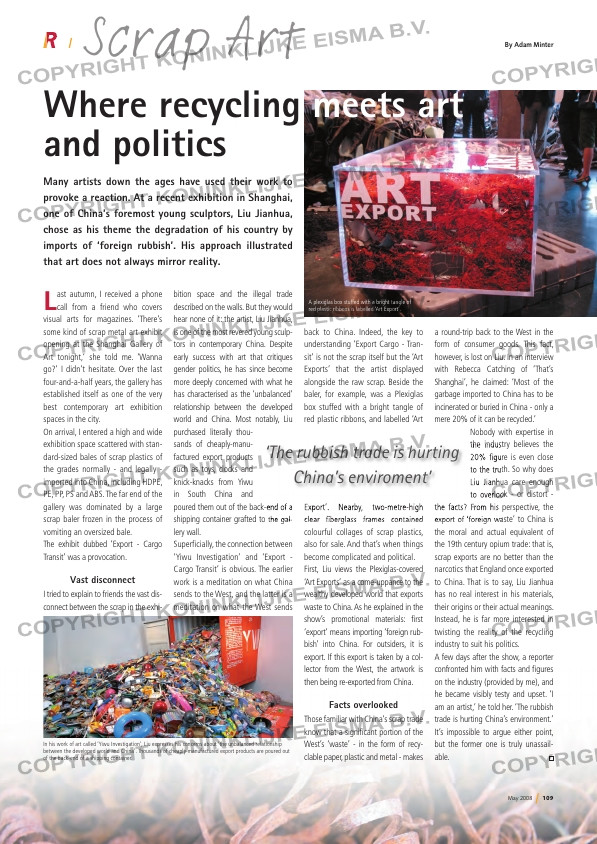Page 109 from: May 2008

May 2008 109
By Adam Minter
Last autumn, I received a phone call from a friend who covers
visual arts for magazines. ‘There’s
some kind of scrap metal art exhibit
opening at the Shanghai Gallery of
Art tonight,’ she told me. ‘Wanna
go?’ I didn’t hesitate. Over the last
four-and-a-half years, the gallery has
established itself as one of the very
best contemporary art exhibition
spaces in the city.
On arrival, I entered a high and wide
exhibition space scattered with stan-
dard-sized bales of scrap plastics of
the grades normally – and legally –
imported into China, including HDPE,
PE, PP, PS and ABS. The far end of the
gallery was dominated by a large
scrap baler frozen in the process of
vomiting an oversized bale.
The exhibit dubbed ‘Export – Cargo
Transit’ was a provocation.
Vast disconnect
I tried to explain to friends the vast dis-
connect between the scrap in the exhi-
bition space and the illegal trade
described on the walls. But they would
hear none of it: the artist, Liu Jianhua,
is one of the most revered young sculp-
tors in contemporary China. Despite
early success with art that critiques
gender politics, he has since become
more deeply concerned with what he
has characterised as the ‘unbalanced’
relationship between the developed
world and China. Most notably, Liu
purchased literally thou-
sands of cheaply-manu-
factured export products
such as toys, clocks and
knick-knacks from Yiwu
in South China and
poured them out of the back-end of a
shipping container grafted to the gal-
lery wall.
Superfi cially, the connection between
‘Yiwu Investigation’ and ‘Export –
Cargo Transit’ is obvious. The earlier
work is a meditation on what China
sends to the West, and the latter is a
meditation on what the West sends
back to China. Indeed, the key to
understanding ‘Export Cargo – Tran-
sit’ is not the scrap itself but the ‘Art
Exports’ that the artist displayed
alongside the raw scrap. Beside the
baler, for example, was a Plexiglas
box stuffed with a bright tangle of
red plastic ribbons, and labelled ‘Art
Export’. Nearby, two-metre-high
clear fi berglass frames contained
colourful collages of scrap plastics,
also for sale. And that’s when things
become complicated and political.
First, Liu views the Plexiglas-covered
‘Art Exports’ as a come-uppance to the
wealthy developed world that exports
waste to China. As he explained in the
show’s promotional materials: fi rst
‘export’ means importing ‘foreign rub-
bish’ into China. For outsiders, it is
export. If this export is taken by a col-
lector from the West, the artwork is
then being re-exported from China.
Facts overlooked
Those familiar with China’s scrap trade
know that a signifi cant portion of the
West’s ‘waste’ – in the form of recy-
clable paper, plastic and metal – makes
a round-trip back to the West in the
form of consumer goods. This fact,
however, is lost on Liu. In an interview
with Rebecca Catching of ‘That’s
Shanghai’, he claimed: ‘Most of the
garbage imported to China has to be
incinerated or buried in China – only a
mere 20% of it can be recycled.’
Nobody with expertise in
the industry believes the
20% fi gure is even close
to the truth. So why does
Liu Jianhua care enough
to overlook – or distort –
the facts? From his perspective, the
export of ‘foreign waste’ to China is
the moral and actual equivalent of
the 19th century opium trade: that is,
scrap exports are no better than the
narcotics that England once exported
to China. That is to say, Liu Jianhua
has no real interest in his materials,
their origins or their actual meanings.
Instead, he is far more interested in
twisting the reality of the recycling
industry to suit his politics.
A few days after the show, a reporter
confronted him with facts and fi gures
on the industry (provided by me), and
he became visibly testy and upset. ‘I
am an artist,’ he told her. ‘The rubbish
trade is hurting China’s environment.’
It’s impossible to argue either point,
but the former one is truly unassail-
able.
Many artists down the ages have used their work to
provoke a reaction. At a recent exhibition in Shanghai,
one of China’s foremost young sculptors, Liu Jianhua,
chose as his theme the degradation of his country by
imports of ‘foreign rubbish’. His approach illustrated
that art does not always mirror reality.
A plexiglas box stuffed with a bright tangle of
red plastic ribbons is labelled ‘Art Export’.
Where recycling meets art
and politics
In his work of art called ‘Yiwu Investigation’, Liu expresses his concerns about ‘the unbalanced relationship
between the developed world and China’. Thousands of cheaply-manufactured export products are poured out
of the back-end of a shipping container.
Scrap Art
‘The rubbish trade is hurting
China’s enviroment’
RI_060 Scrap ART-China.indd 1 14-05-2008 14:03:51



